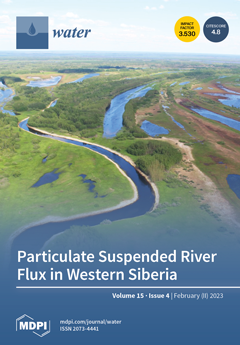This study collected 31 water samples from the Tongzi River, Guizhou Province, Southwest China to conduct a risk assessment to understand the hydrochemical characteristics and major ion sources of irrigation and drinking water quality and their effects on human health. The results showed that ion abundance in the Tongzi River is Ca
2+ (66%) > Mg
2+ (24%) > K
++Na
+ (10%) for cations and HCO
3− (75%) > SO
42−(21%) > Cl
− (4%) for anions. Additionally, the hydrochemical type of the water is Ca-Mg-HCO
3, controlled by carbonate weathering. Methods including ion ratios, principal component analysis (PCA), and correlation analysis (CA) were used to analyze the source of main ions in the river water. PC1, with the most significant variance (54.9%), decides the hydrochemical characteristics and is affected by the positive loadings of SO
42− (0.92), pH (0.85), Ca
2+ (0.80), Cl
− (0.72), Na
+(0.66), NO
3− (0.65), and K
+ (0.57). PC2 explains 19.2% of the total variance, with strong positive loadings of Na
+ (0.75), K
+ (0.63) and Cl
− (0.59). Mg
2+ (0.84) and HCO
3− (0.85) exhibits high loadings in PC3, explaining 9.3% of the variance. The results showed that intensive agricultural activities in the basin were the main source of nitrate NO
3−, whereas SO
42− was mainly derived from mining activities. The lower concentrations of Na
+, K
+, and Cl
− were from coal combustion, domestic wastewater discharge, and agricultural fertilizer applications. The study area was mainly affected by carbonate rock weathering; natural processes (mainly the weathering of carbonate rocks) were still the main origin of Ca
2+, Mg
2+, and HCO
3−. Moreover, the United States Salinity Laboratory (USSL) diagram and the Wilcox diagram showed that 100% of the samples fell in the C2S1 zones, and the water quality had good suitability for irrigation. The health risk assessment (HRA) results showed that HQ
NO3− was much larger than HQ
NH4+ and indicated that nitrate pollution dominated non-health hazards. About 6.5% of the samples in the tributaries represented an unacceptable risk for infants and children, and the HQ value for infants and children was always higher than that for adults. Additionally, the non-carcinogenic health risk of riverine ions for infants and children in the Tongzi River was very noteworthy, especially in the tributaries.
Full article





